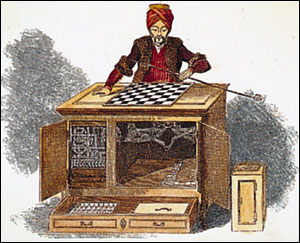Nanoviews: Exploring Consciousness, The Turk and more...
By
Short takes on six books
Short takes on six books

DOI: 10.1511/2002.33.0
If you really want to spook yourself some stormy night, try reading Exploring Consciousness by science writer Rita Carter (University of California Press, $35). Carter tells us about the centuries-old quest for the “ghost in the machine”: how it is that physical stuff produces the experience of what it is like to be a human being—say, the joy of eating a dish of vanilla ice cream or the mental struggle of thinking about hard problems like the nature of consciousness. Through accounts of thought experiments and laboratory studies, Carter gives us a sense of how eerie consciousness really is. Consider the following experiment on free will: Subjects are hooked up to an electroencephalograph and asked to initiate a hand movement whenever they feel like it. In hundreds of trials, scientists have found that the readiness potential—electrical activity in the brain that precedes any voluntary action by about half a second— appears about 350 to 400 milliseconds before a subject is conscious of the urge to move his or her hand. So who’s actually making the decisions? Is consciousness just a passive observer—a couch potato watching the game on TV? Carter offers us a ghost story that also turns out to be a whodunit. (Below: What is it like to be a chimp?)

From Exploring Consciousness
The Turk was a chess-playing automaton consisting of a wooden box with a drawer and several compartments jammed with gears and camshafts, behind which sat a turban-clad robotic figure that moved pieces about the chessboard placed on the box. From its 1770 debut before the empress of Austria-Hungary until its anticlimactic death-by-fire in Philadelphia 85 years later, the device took on most comers and inspired wonder and debate among all who saw it compete. So popular that it survived its inventor, Hungarian engineer Wolfgang von Kempelen, the machine passed through several hands and across several land masses, performing before such luminaries as Napoleon, Charles Babbage and Edgar Allan Poe (who is said to have invented the detective-story genre while unmasking the Turk’s secret). Tom Standage’s The Turk (Walker, $24) is a marvelous, post-Deep Blue retelling of, as its subtitle says, “The Life and Times of the Famous Eighteenth-Century Chess-Playing Machine.” Standage suggests that Kempelen’s creation was much more than a conversation piece; he argues that the Turk, which could utter “check” in a croaky machine voice, anticipated the famous Turing test for machine intelligence by 200 years and gave young Babbage some heady ideas for his future experiments with calculating machines.

From The Turk
Paula Berinstein’s Making Space Happen: Private Space Ventures and the Visionaries Behind Them (Plexus Publishing, $24.95) probes the community of entrepreneurs trying to open up the final frontier through commercial activities. Will space tourism (to destinations like the one shown below) or asteroid mining finally push us to become a space-faring civilization? Perhaps so, at least according to the many movers and shakers that Berinstein details here. Poorly edited, the book is repetitious and has a strangely choppy style; still, it provides an entertaining account of the hopes, dreams and plans of key people in this movement. For example, Berinstein profiles Jim Benson, who—after making a fortune in the software industry—founded SpaceDev, a now publicly traded company working to land a space probe on a near-Earth asteroid and claim it. Others detailed in the book include John Lewis, the University of Arizona astronomer who advocates mining asteroids; Buzz Aldrin, the second man to set foot on the moon; and Dennis Tito, the first private citizen to pay his own way into space. Berinstein quotes such colorful characters at length, providing much insight into their thinking about where one day we may all be able to boldly go.

From Making Space Happen: Private Space Ventures and the Visionaries Behind Them
Did people domesticate cats, or vice versa? The answer to this and many other puzzles about our often-mysterious furry friends can be found in Steven Budiansky’s latest treatise on animal behavior, The Character of Cats: The Origins, Intelligence, Behavior, and Stratagems of Felis silvestris catus (Viking: $24.95). Within this book’s well-crafted pages, one can learn the place of the domestic cat in history—did you know that cheetahs were once domesticated as hunting assistants?—and the essentials of cat behavior. Most cat people, however, will hurry to the last three chapters, where Budiansky takes on cat intelligence, personality and misbehavior—even managing to offer some useful recommendations for dealing with the last. If you’re a cat person, there’s nothing to consider; you need this book. If not, you’ll at least get some entertaining hints about that form of dementia.In addition to succeeding domestically, Felis sylvestris continues to flourish in the wild—in Europe, Africa and Asia, wildcats are thought to number in the millions. The African wildcat (the lybica group of Felis silvestris) (below) is tameable enough that it might have been taken in by the ancient Egyptians.

From The Character of Cats: The Origins, Intelligence, Behavior, and Stratagems of Felis silvestris catus
When we eventually discover life on another planet, will it be so fantastic in form, so beguiling in behavior that it will utterly astonish us? Or are the creatures of our own planet sufficiently peculiar to cover the full range of life’s bizarreness in this universe? You can judge for yourself by flipping through the pages of John Downer’s collection of Earth’s living oddities in Weird Nature: An Astonishing Exploration of Nature’s Strangest Behavior (Firefly Books, $19.95 paper). Downer divides the book into various categories of strangeness: peculiar relationships between species (a shrimp acts like an attendant at a beauty parlor, grooming and cleaning a fish while it visits a coral reef [far left]); weird ways to have sex (hermaphroditic sea hares form long orgiastic chains); ridiculous ways to procure food (the fly-snagging tongue of a chameleon can accelerate with a force of 50 g); and curious ways to experience reality (reindeer will travel miles to munch on hallucinogenic mushrooms, and just seem to hang out afterward [left]). And, of course, there is what may be the most outlandish animal of all: the human being, which can occasionally be found drinking the urine of the intoxicated reindeer, as Siberian shamans do, to travel to an “upper realm.” We might not be astounded by life on another planet, but, as Downer’s book reveals, alien life will surely be dumbfounded by us.

From Weird Nature.

From Weird Nature.
The beguiling baby elephants in Wild Orphans (Welcome Books, $24.95) are irresistible. The wonderful photographs by Gerry Ellis (who also wrote the heartfelt, if somewhat disjointed, text) show traumatized young elephants being rescued, airlifted to the David Sheldrick Wildlife Trust orphanage in Nairobi and affectionately nurtured there by Kenyan keepers. These men provide the orphanswith nearly constant attention, bottle-feeding them (an infant drinks 10 gallons of milk a day), wrapping them in blankets to simulate a mother’s contact and sometimes even sleeping with them. Older orphans are eventually moved to Tsavo National Park. Still watched over by humans, they roam the bush during the day and return to a stockade at night. At Tsavo they will grow to youthful maturity before eventually being released into the wild. It is hoped that the females in the group Ellis is following will form their own herd. Many of the photos, like the one below, show the elephants’ playfulness and fondness for their keepers.

From Wild Orphans
Click "American Scientist" to access home page
American Scientist Comments and Discussion
To discuss our articles or comment on them, please share them and tag American Scientist on social media platforms. Here are links to our profiles on Twitter, Facebook, and LinkedIn.
If we re-share your post, we will moderate comments/discussion following our comments policy.